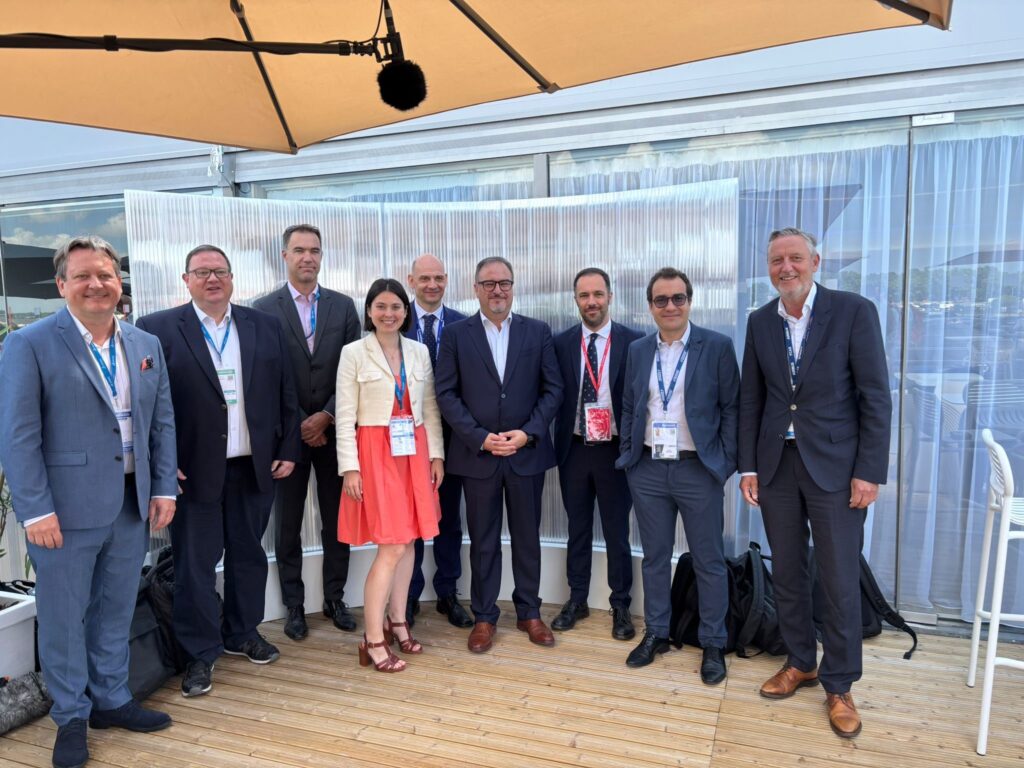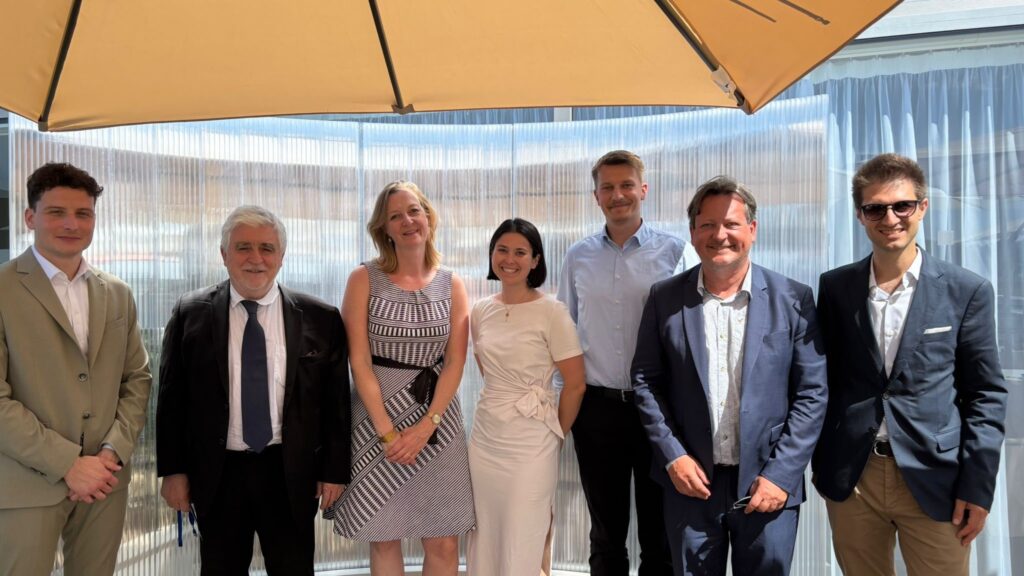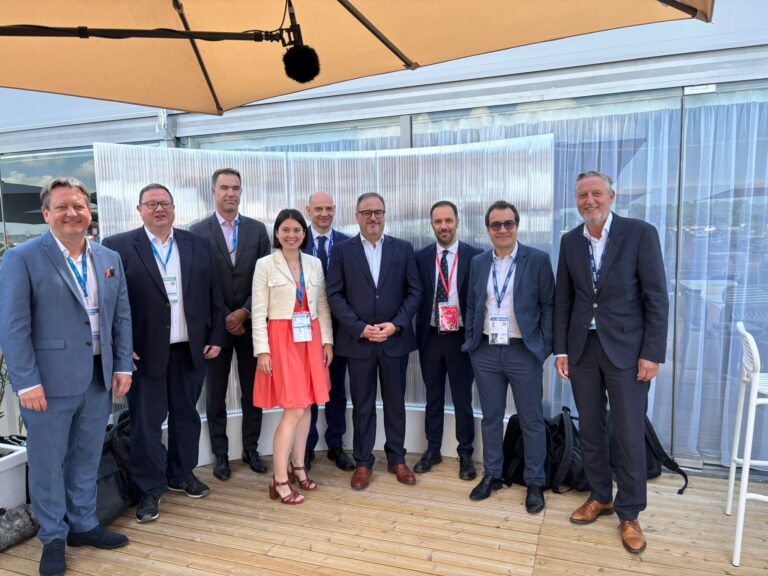AEROSEC: News From the 2025 Paris Air Show
At the 2025 Paris Air Show, AEROSEC took center stage as a flagship example of European innovation in secure digital collaboration for defense. As a Digital Europe Programme co-funded project, AEROSEC will deliver the design of a sovereign, Highly Secure Multi Cloud European platform (HSMP), gathering major industry players Airbus Defense and Space, Dassault Aviation, Indra Systems, Leonardo, Dassault Systèmes, 3DS OUTSCALE and Cefriel. At the Bourget, AEROSEC demonstrated the pioneering spirit of its members to pave the way to ensure the European Union (EU) masters the strategic tools required to strengthen technological sovereignty, accelerate military co conception, and boost European defense competitiveness.

Alexis Balloy, Dassault Systèmes
Arnaud Bertrand, Outscale
David Ziegler, Dassault Systèmes
Juliette Renaut, AEROSEC Project Coordinator
Mirco Masa, Cefriel
Andrés Escribano Riesco, Indra
Stefano Racca, Leonardo
Laurent Bendavid, Dassault Aviation
Joerg Wirtz, Airbus Defense and Space
The Paris Air Show provided the ideal platform to reunite the project executives, providing strategic insights for the project, as well as announce the University partnerships on the Model-Based System Engineering demonstrator which will be developed in collaboration with Politecnico di Milano, ESTIA-ISAE SUPAERO, Helmut Schmidt University, Delft University of Technology, Linkoping University, and Kaunas University of Technology.

AEROSEC: Context
Over the past decade, the European Union has clearly recognized the need to reflect on the future European security architecture, as well as the need for Europe to invest in its own security and defense. Most recently, the rising and complex nature of threats facing Europe, and the reshaping of the world order, has further reinforced this momentum, urging Europe to take the next steps on defense.
Realizing a True European Single Market for Defense Taking into Account the Programs’ Growing Complexity
In pursuit of a genuine Single Market for defense products and services, one of the most pressing challenges—particularly with the rise of multi-country defense programs—is the need for a secure, cloud-based, collaborative, and interoperable working environment built on reusable components and standardized technologies. Addressing this gap is critical to achieving the vision of a true Single European Defense Market, especially as military programs evolve into increasingly complex systems of systems (SoS) involving large, multi-tiered industrial and State consortia. These organizations must operate within a Common Work Environment (CWE), tailored to the specific program but interoperable across national and corporate boundaries. Currently, each new program requires participating partners to invest significant time and resources into designing a bespoke CWE, defining collaborative spaces, tools, and workflows from scratch. This repetitive effort delays the actual launch of program activities and creates inefficiencies across the defense value chain. Yet many core elements of CWEs—such as key actors, collaboration structures, activities, infrastructure, and enabling technologies—are common across programs. Failing to address this foundational need undermines efforts to simplify cooperation, control costs, and speed up delivery. Ultimately, it is a structural barrier to Europe’s defense competitiveness and strategic autonomy.
The Need for a Cloud-based Collaborative, Secure and Interoperable Working Environment
The European defense industry faces unique challenges due to the high levels of data sensitivity coupled with unharmonized security classification which are fragmented between national schemes and lack mutual recognition between EU Member States. At the same time, the industry’s operating environment needs increased cooperation and is becoming more distributed driven by the widespread adoption of digital tools across engineering, project management, manufacturing, and support functions. This digital transformation is rapidly advancing within individual companies and government agencies, but significant difficulties arise when these entities must collaborate across organizational and national boundaries.
In order to achieve a cloud-based collaborative, secure and interoperable working environment, a first step needs to be taken at the legislative level. Indeed, a harmonized referential for cyber-security and cloud-based data protection in the defense sector, as well as for the handling of restricted data, must be proposed and adhered to by EU Member States. This referential would end European fragmentation for working with cloud-based defense related data, as well as provide a European basis in line with the EU ambition for greater cooperation in defense, facilitating multi country/industrial collaboration.
Past the legislative hurdle, two main barriers remain in the way of effective cloud-based collaboration. First, the establishment of secure, trusted network interconnections—reusable across multiple military programs—remains complex. Second, interoperability issues persist due to differences in the digital tools and platforms used by different organizations for similar tasks, hampering seamless collaboration.
To realize the vision of a true Single Market for Defense, it is time to accelerate the development of a secure and sovereign “EU Restricted Cloud.” This should be grounded in common requirements, harmonized regulations, shared accreditation frameworks, and validated technical solutions—mutually recognized by all relevant organizations across EU Member States. Such an initiative is essential not only to enable cross-border collaboration but also to reinforce European digital sovereignty and defense readiness.
AEROSEC: A European Competitiveness Enabler

To overcome these persistent challenges, AEROSEC will deliver a sovereign HSMP featuring a secure network, federated identity and access management, and multi-cloud, multi-application capabilities—enabling faster, more secure, and more efficient collaboration at scale, safeguarding data from unauthorized access.
This architecture will provide a common base to all military programs and be customizable for all defense program participants, reused across funding programs and ultimately serve the development of European Defense flagship projects and the European Defense Fund projects.
By identifying these foundational elements and unifying them into a secure, reusable base architecture—adaptable at marginal cost to each program’s specificities—AEROSEC will transform how Europe designs and executes defense programs. This standardization is not just a technical advancement; it is a strategic imperative for ensuring European sovereignty, resilience, and industrial leadership.
AEROSEC will furthermore serve as a key demonstrator for applying Model-Based Systems Engineering (MBSE) in defense acquisition, showcasing how digital engineering practices can be embedded across the full lifecycle of complex military programs. By integrating MBSE into a secure, cloud-based collaboration environment, AEROSEC will enable all stakeholders—from system architects to operational planners—to work from a unified, continuously updated digital model. This approach enhances traceability, reduces design errors, accelerates validation and verification, and supports real-time decision-making across multiple organizations and nations. Ultimately, this strengthens European industrial competitiveness and strategic autonomy—ensuring that critical defense capabilities are developed, managed, and sustained within a sovereign and resilient European defense ecosystem while improving European efficiency, speed and reducing costs.
More about AEROSEC: https://www.aerosec-securecloud-dep.eu/ and https://www.linkedin.com/company/aerosec-eu-project/
More about Dassault Systèmes capabilities: https://www.3ds.com/industries/aerospace-defense/defense

